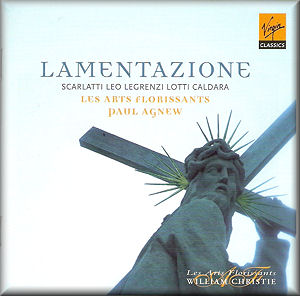 |
 |
|


alternatively
CD: MDT
AmazonUK
AmazonUS
Sound
Samples & Downloads |
Lamentazione
Domenico SCARLATTI (1685-1757)
Stabat Mater, for 10 voices (c. 1715) [23:20]
Antonio LOTTI (1666–1740)
Crucifixus, for 10 voices [2:35]
Giovanni LEGRENZI (1626-1690)
Quam amarum est, Maria (pub. 1655) [5:11]
Antonio CALDARA (1670-1736)
Crucifixus, for 16 voices [4:01]
Leonardo LEO (1694-1744)
Miserere a due cori (1739) [18:32]
Antonio LOTTI
Crucifixus, for 8 voices (c. 1717/19) [2:41]
 Les Arts Florissants/Paul Agnew
Les Arts Florissants/Paul Agnew
rec. 26 September 2010, Abbaye d’Ambronay, France
 VIRGIN CLASSICS 0709072 [56:20]
VIRGIN CLASSICS 0709072 [56:20]
|
|
|
The laments recorded in this disc date from around 1655 to
1739. This period saw a succession of sacred laments for Holy
Week but the ones featured in Paul Agnew’s programme all largely
employ stile antico, the deliberate cultivation of
an antique idiom. There are frequent imitative passages, rich
polyphony, and a sense of intense expressive depth. The composers’
intention was a revival of sixteenth century a cappella
singing, but by means of evocation not mere copying. There is
a small continuo, of cello, theorbo and organ.
It’s appropriate that Agnew and Les Arts Florissants should
begin with Scarlatti’s Stabat Mater as it was one of
the most popular sacred pieces of the time, and has been widely
performed and recorded in our time. It’s scored for ten-part
choir, though Scarlatti strategically reserves the full resources
of the choir for optimum moments; otherwise the textures remain
light, and pure. Agnew has exercised editorial latitude to employ
the choir throughout, apart from two brief passages where there
is an answering of tutti to solo passages. The conflict on this
point between surviving manuscripts has allowed him, very properly,
to decide on this division, and as a most experienced singer
himself he justifies the decision with assurance. What Agnew
most wants is a ‘flow of emotion’ and it’s this quality, the
shifting densities of choral tone and amplitude, and the exemplary
projection of imitative passages, that consistently impresses.
Antonio Lotti is represented by two brief Crucifixus settings,
intended for Mass, one a 10 and the other a 8.
They both exemplify qualities of taut, dissonant polyphony,
remarkably so in the former case. In the setting a 8
the harmonic steps are very well delineated and the reflective
melancholy and intimacy of the setting offer a suitable envoi
for the programme as a whole. Giovanni Legrenzi’s Quam amarum
est, Maria is the earliest setting. Legrenzi was one of
Lotti’s teachers, which furnishes both biographical and musical
interest as well as providing a kind of lineage to the selection.
His motet is set for two sopranos and continuo, and functions
as a kind of ‘lament and love duet’ of quite remarkable and
direct expressive power. Caldara’s brief but moving Crucifixus
a 16 is even richer and more refulgent, a massively Venetian
affair, demonstrative and full of ripe grandeur, and vast technical
assurance. After Scarlatti’s, the most extensive setting is
that of Leonardo Leo’s Miserere. His old-school polyphonic
approach, with its two alternating choirs, also exerts a powerful
effect. The blocks of chorus alternating with plainsong (single
voice) accompanied by organ gives the music density as well
as simplicity, and is later varied and integrated. There are
hints of a more contemporary style from time to time but the
music remains essentially in thrall to earlier models, and profitably
so. The full choir, as with Scarlatti, is only sparingly unleashed
and it’s all the more startling and impressive when it is. Richard
Wagner heard the work in Naples in 1880, calling it ‘sublime
and significant’.
This recital was recorded live, and most impressively, in the
Abbaye d’Ambronay. There is great purity and sensitivity in
the singing of Les Arts Florissants, both in tuttis and in solos.
Laments have seldom been in better hands, or voices.
Jonathan Woolf
see also review by Michael
Cookson
|
|

